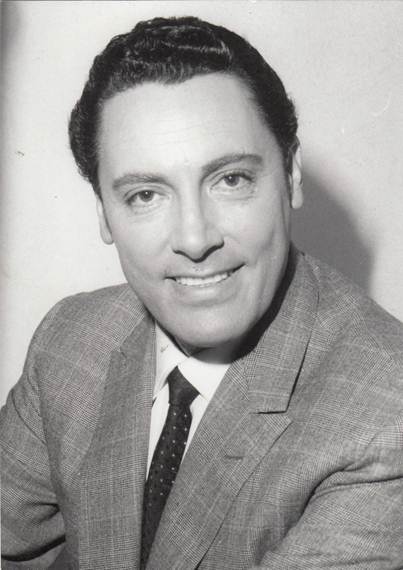 (photo Charles Mintzer coll.)
(photo Charles Mintzer coll.) 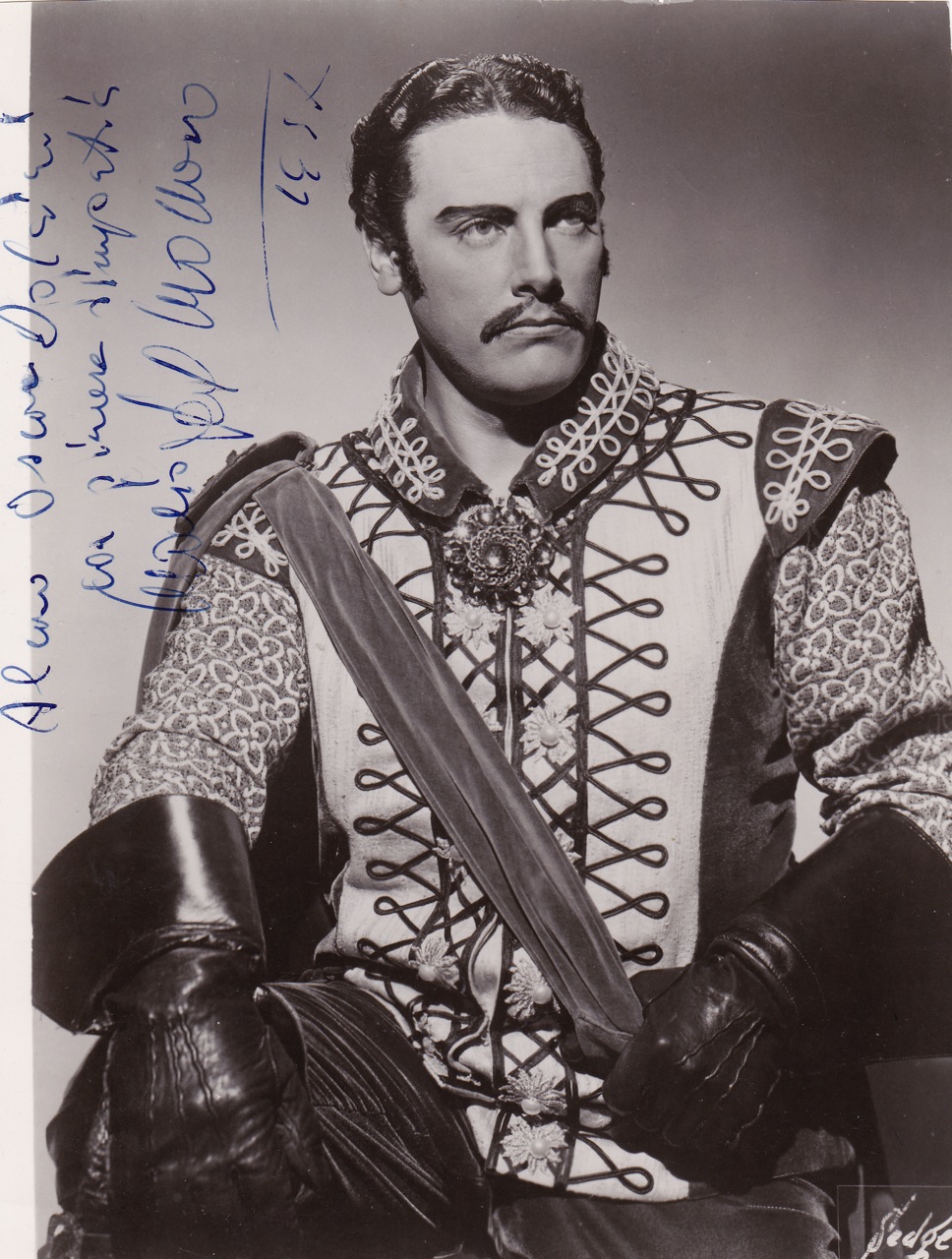 (an imposing don Alvaro, coll. Charles Mintzer)
(an imposing don Alvaro, coll. Charles Mintzer)LOOKING BACK ON MARIO DEL MONACO by David AKINS
(all photos courtesy David Akins, Charles Mintzer collections)
 (photo Charles Mintzer coll.)
(photo Charles Mintzer coll.)  (an imposing don Alvaro, coll. Charles Mintzer)
(an imposing don Alvaro, coll. Charles Mintzer)
Introduction by Charles Mintzer
David Akins is a gentleman who I first met in the opera autograph world several years ago. David is a diligent, exhaustive and knowledgeable collector and he and I had several long conversations about singers over the years at autograph shows in New York. When I realized that David, a huge Del Monaco admirer, had interesting memories of the tenor, I wanted to put him in contact with our editor, who shares that enthusiasm, but life’s complications made that difficult to accomplish. David has put some of his reminiscences about singers he heard in his youth in California in this long letter/essay to Rudi. We all have had operatic experiences and formed opinions about singers we heard over the years, but David’s journey in the world of opera and singers is of rare value, largely because he is also a “thinker” about singers and the overall operatic scene. Not only did he hear many legendary artists, but in later years he both interviewed and often photographed them. I hope this is merely installment number one of many of his observations and thoughts. David often heard the San Francisco opera on their annual visits to Los Angeles where he lived, but he did journey up to San Francisco on occasion. For a brief time David was living in Houston (1952) and his first Metropolitan operas were there on the Met national tour (May 2 and May 3, that year) David told me that he also heard Flagstad, Bjoerling and De los Angeles in concert in Houston that season. Even as a very young man, David would go backstage and ask singers to sign his autograph book. Bjoerling who wasn’t seeing fans after his Houston concert finally emerged from his dressing room with two gentlemen, the Swedish consular in Houston and a Captain Carlson who had enjoyed great fame at the time for helping save a sinking ship in the North Atlantic, heavily publicized on TV. Bjoerling insisted that Carlson also sign David’s autograph book. Bidu Sayao told David she never met a fan who asked her so many good questions. She told him that her greatest regret was that her voice was not heavy enough to sing Cio-Cio-San, but she was happy to sing Nedda and Margherita in “Mefistofele” at the end of her career in California. David can regale you for hours with his memories of the artists he heard over the years, so here is his Del Monaco, and to an extent his Bjoerling, tribute in the form of a letter to our editor.
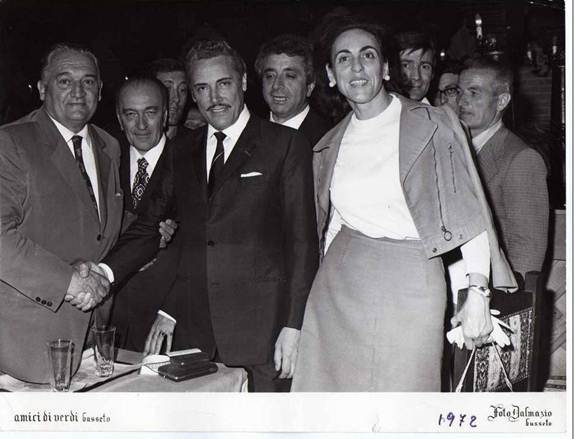
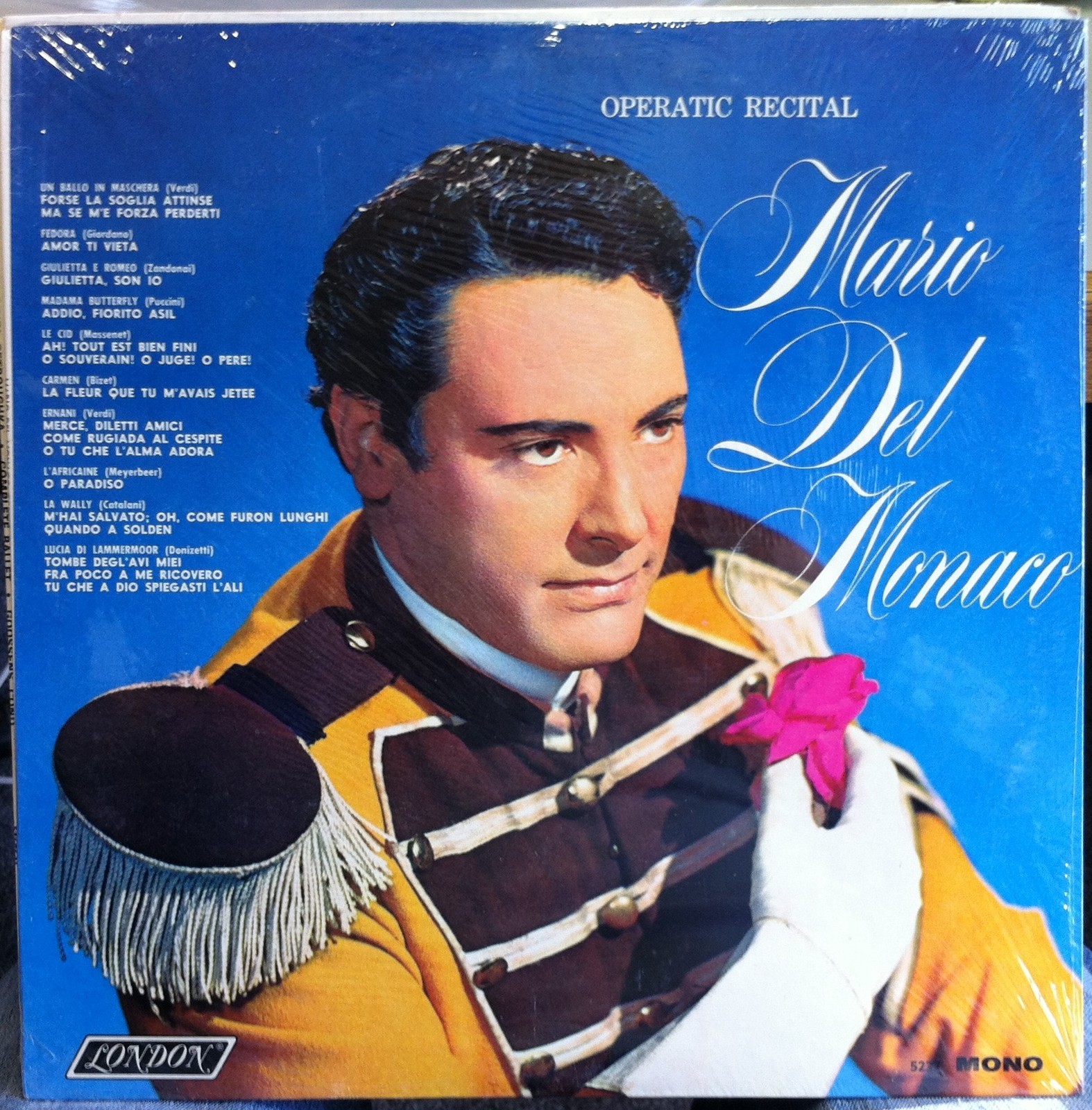
Dear Rudi,
I want to thank you for your very nice letter of October 31st, and I apologize for not responding sooner. Unfortunately, I am so up to my ears in things to do that I am still a computer illiterate, and depend upon my wife for on-line communications. Thank you for your greetings from Flanders, as I have been to Ghent, Bruges, and Antwerp on a number of occasions, and I believe Bruges to be the most beautiful small city in the world. And as you know, that's saying a lot because there are so many beautiful small cities in the world.
Although I had heard opera over the radio at age 13 (Mario Lanza and the Met broadcasts), and went to my first vocal recitals of great singers at age 14, my first opera experience was at the age of 15 during the Met's 1951 season. I heard Del Monaco, Milanov, and Valentino in "Cavalleria" on a double bill with "Pagliacci," the cast of which included Vinay, Merrill, Guarrera, Hayward, and Delia Rigal, both conducted by Alberto Erede. [This was in Houston, Texas on the Met tour May 1952.] I actually didn't know what to think when I first heard Del Monaco because the records I had from "Cavalleria" featured Gigli and Bjoerling and I was expecting a beautiful lyric sound and instead, I heard a trumpet from behind the curtain. This was a role that Del Monaco continued to record commercially on at least three occasions, but I believe he dropped from his repertoire the next season. Vinay's voice was a bit chest heavy and did not carry very well in the theater, but he was an extremely handsome man and a very fine actor. And as I was sitting in the third row of the orchestra, both performances were very enjoyable. The next night I heard a performance of "Rigoletto" with Tucker, Leonard Warren, and Genevieve Warner, an American soprano who replaced the previously announced Patrice Munsel, again under Erede. Tucker's voice was a bit dry at that time, and my impression was that he was only competent. He was considered the house tenor at the Met because he was very consistent and sang most of the standard repertoire, excluding the heaviest roles. Warren was the Met's first baritone, and remains to this day the greatest baritone I have ever heard. His only competition was Cornell MacNeil who came to the Met slightly less than a year before Warren died in 1960. Although MacNeil was an equally great voice, Warren was the greater artist and technician. Robert Merrill had a beautiful voice, but as long as Warren lived, he remained the second leading baritone in the company. Genevieve Warner's career ended the following summer while singing at the Edinburgh festival. She was assaulted and robbed, and died of her injuries two years later.
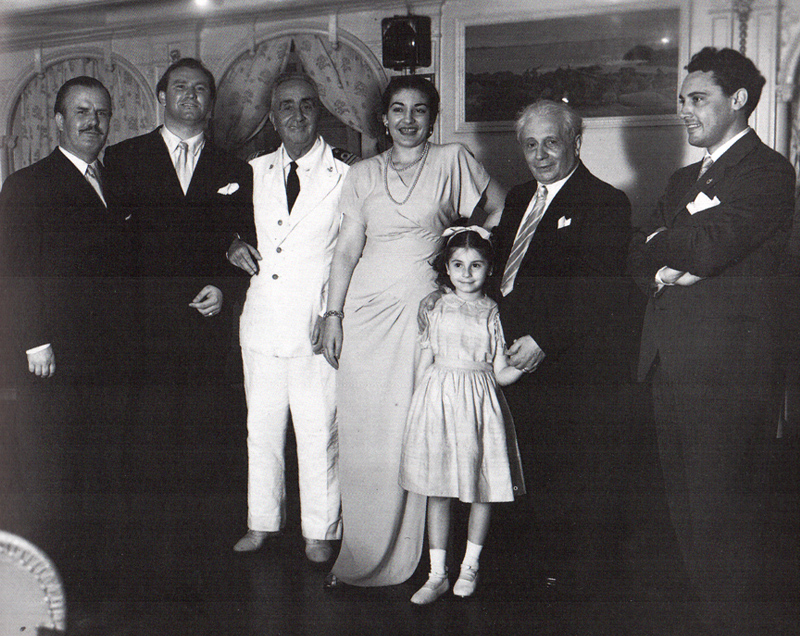 (on the way to South America from left to right Filippeschi, Rossi-Lemeni, Callas, Serafin and MdM)
(on the way to South America from left to right Filippeschi, Rossi-Lemeni, Callas, Serafin and MdM)
I next heard Del Monaco at the San Francisco Opera where he had made his American debut in the Fall of 1950, being a replacement, believe it or not, for Mario Lanza. Lanza had agreed to open the season in "Andrea Chenier" with his idol Licia Albanese as Maddalena. MGM, who had invested so much money in Lanza, forbade him to sing, fearing the possibility of poor review which might damage their investment. Gaetano Merola, the founder and principal conductor of the San Francisco Opera, turned to Frank De Bellis, a wealthy record collector (a man who five years later became a friend of mine), to ask his advice as to who were the most prominent Italian tenors to replace Lanza. De Bellis played recordings of both Del Monaco and Tebaldi, and thus these two giants made their American debuts on the opening night of the 1950 season, in "Aida." Rudolf Bing, who was in his first season as manager at the Met, came to San Francisco for the opening night and offered Del Monaco an audition performance at the Met of "Manon Lescaut" on his way back to Italy from San Francisco. Del Monaco was paid $300 for the performance, for which he never forgave Bing, and so their relationship, which was to continue for approximately ten years, on and off, began badly.
I heard Del Monaco again in San Francisco about six months after the "Cavalleria" in "Aida," "Trovatore," and "Pagliacci." The "Aida" and "Trovatore" were both with Herva Nelli (Toscanini’s then favorite dramatic soprano, who later became a cook for Jacqueline Kennedy) and the "Pagliacci" was with Bidu Sayao, finally getting to sing a bit heavier role with the biggest tenor voice in the world. The baritone for all three operas was Frank Guarrera, a very stylish and excellent singer with a medium sized voice, and among the baritones, the greatest actor I have seen. He automatically intuited every part and usually to warm up, he would sing "Esultate" (the tenor’s entrance from “Otello”) in his dressing room. Tenor Brian Sullivan used to knock on his dressing room door and tell him, "Frank, you're making all the tenors nervous." Del Monaco was also scheduled to sing “Il Tabarro” near the end of the season, but he cancelled the performance, and although he later recorded the complete opera, he did not sing the opera on stage until about 20 years later.
I would go almost every night of the season, and the first performance I heard with Del Monaco was "Aida." He would have his back to the audience, much as in the later video from Japan, and whirl around just as he began "Se quel guerrier io fossi" and that line hit you with such volume, beauty, and squillo that if you were sitting down, you almost jumped out of your seat. All of his performances were magnificent. Sayao's husband, the former baritone Guiseppe Danise (who had sung 425 performances with the Met between 1920 and 1932, including the Met premiere of “Andrea Chenier” during his first season) told me that of all the singers he had ever heard, Del Monaco was the most consistent. Baritone George Cehanovsky (the husband of the great soprano Elizabeth Rethberg), who sang and worked at the Met for almost 70 years [forty years as a singer and more years as a diction coach], told me that he had heard every great tenor since the days of creator Tamagno, including Zenatello, and all the others up to Del Monaco, and of them all, Del Monaco was the greatest. All of the tenors at the Met during that period admired Del Monaco immensely. Every time Sullivan, who by the way was a very fine tenor, would discuss tenors, he would begin with Del Monaco.
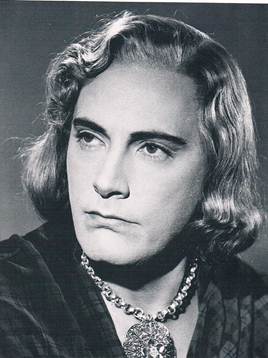 (as Manrico around 1952)
(as Manrico around 1952) 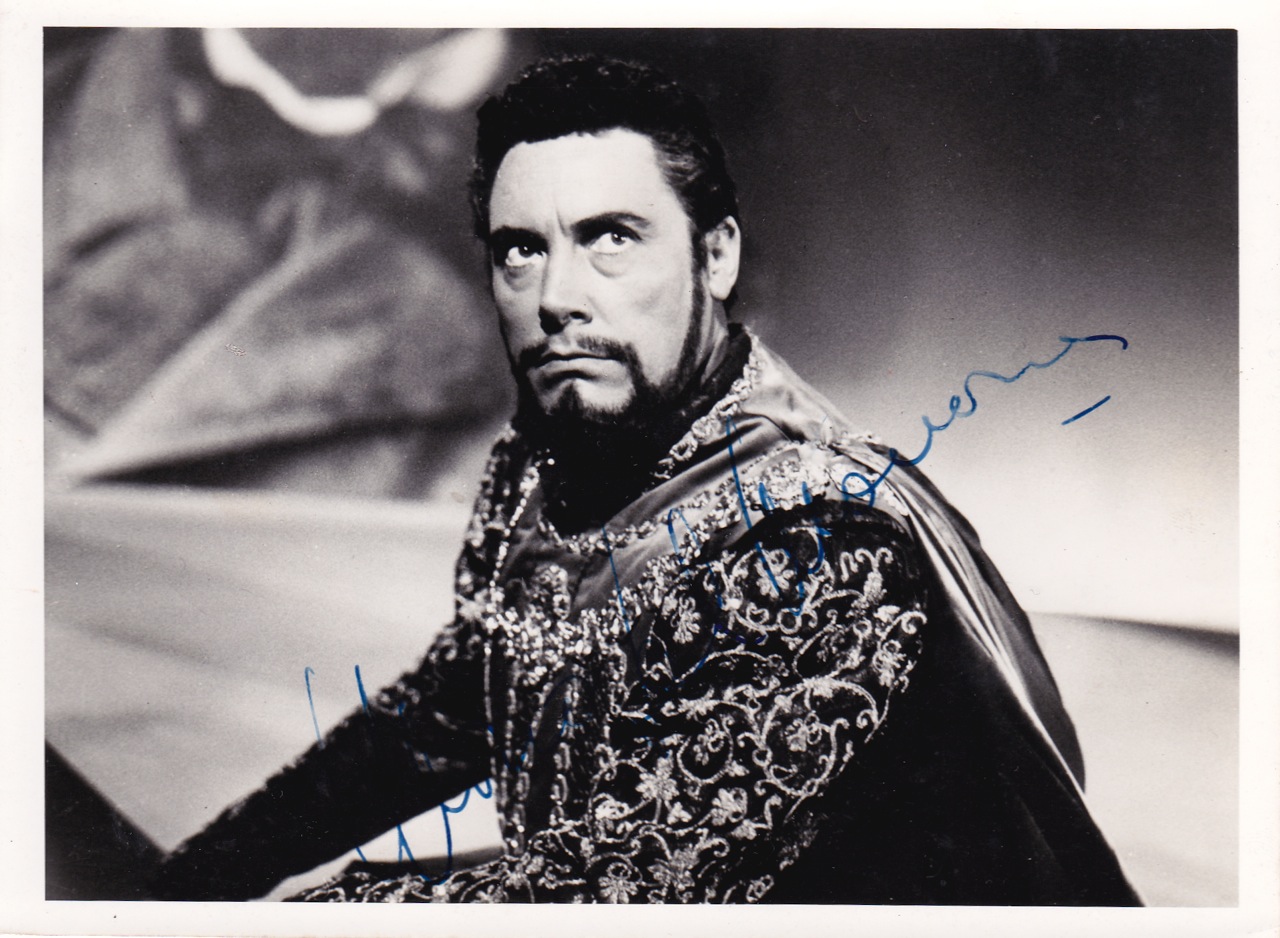 (Otello pose)
(Otello pose)
Del Monaco’s Manrico in “Il Trovatore” was heroic and thrilling. At the end of the third act, after “Di Quella Pira,” the audience was on its feet screaming. The assistant conductor of the Los Angeles Philharmonic Orchestra was sitting next to me, and all he could say was “Unbelievable.” The “Pagliacci” was equally wonderful, and I was amused that many of the Italian ladies sitting in the orchestra section were saying “Canio is so handsome, how could Nedda leave Canio and run off with Silvio?” At that time Del Monaco sang Canio in a brilliant but traditional way and was still wearing the classic Caruso-style Pagliacci costume. His hair was silvered as you see in the great black and white picture that was on his first recording of “Pagliacci.”
 (Pagliacci, Met 1953, courtesy David Akins)
(Pagliacci, Met 1953, courtesy David Akins) 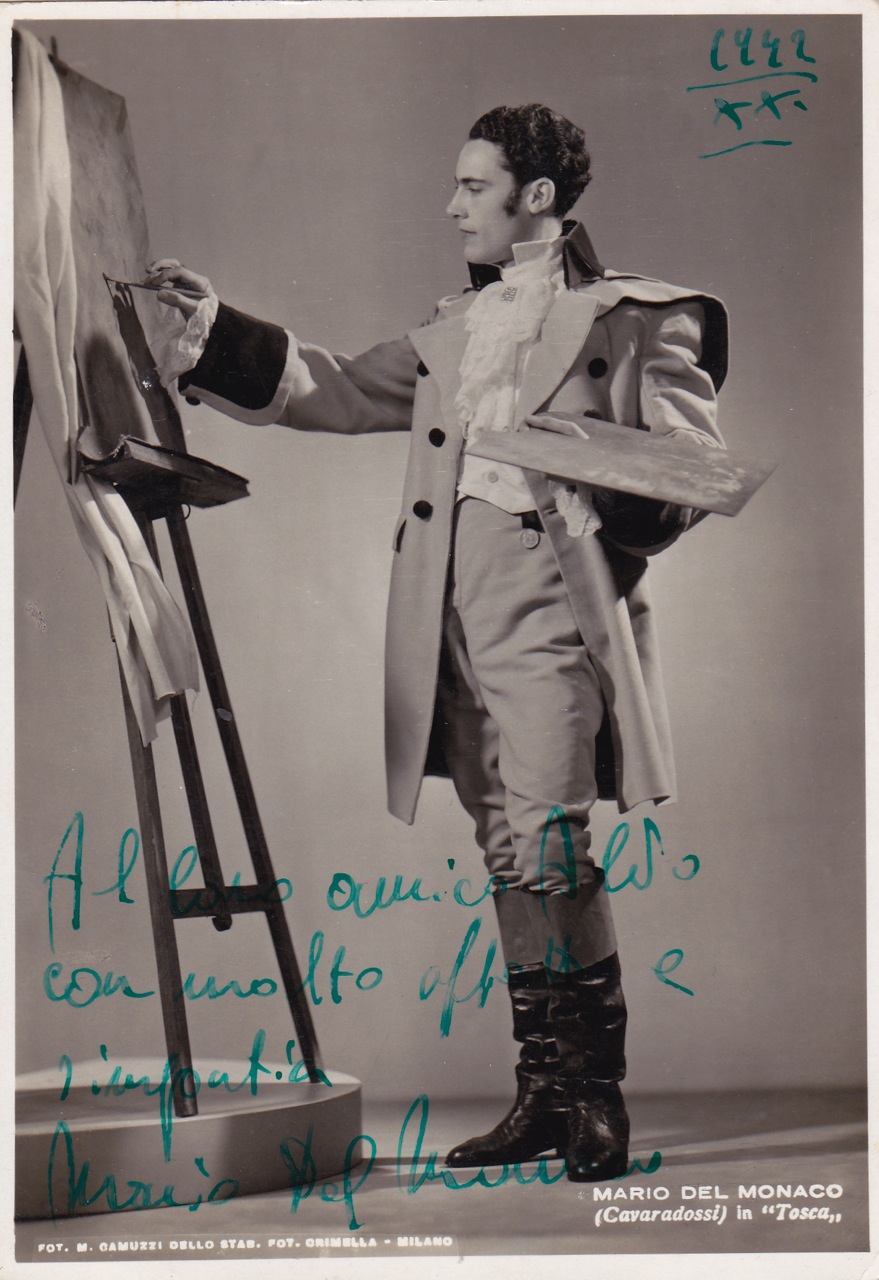 (1942 as Cavaradossi, courtesy C. Mintzer)
(1942 as Cavaradossi, courtesy C. Mintzer)
That season the "Cavalleria" was sung by Jan Peerce and Fedora Barbieri. [October 30, 1952] I spoke with Jan sometime later and he told me, "When I came off the stage after 'Addio alla madre,' there was Del Monaco standing in the wings listening, and he said to me 'You sang well, Peerce.'" Jan, who was a very nice person and had a wonderful sense of humor, considered that the ultimate accolade. I went back to see Del Monaco after one his performances and he was sitting on his dressing table with his feet on the chair. There were only four or five people in the room and he was very cordial and took time to speak with everyone. But as a novice, I could only tell him how much I enjoyed the performance and his incredibly beautiful singing and great voice. I also saw Del Monaco in his dressing room after one of his Met performances. And as you know, Del Monaco was not very large. He was only about five feet seven inches tall, but he wore risers. He was always beautifully and heroically costumed and had great charisma. He looked like a giant on stage. Del Monaco was truly larger than life.
One of the purposes of this article is to explain Mario Del Monaco’s great years, or what I would call his classic career spanning roughly the years 1951 through 1959. During these years, his performances were very carefully thought out and disciplined. Giulietta Simionato used to say that Del Monaco had planned his concept of each role in a very complete or fixed manner and usually performed them during that period with very few variations.
Del Monaco also sang one performance of Faust in Boito’s “Mefistofele” with Sayao and Nicola Rossi-Lemeni in San Francisco during the 1952 season. Rossi-Lemeni, remains the greatest singing actor among the basses that I have ever seen. He was probably a baritone who began singing bass roles before his upper voice was developed, and by pushing for volume, soon damaged his voice. He understood that for Mefistofele and Don Giovanni to succeed, they should be masculine, sexy, attractive and even beautiful (he often wore blond wigs), and appeal to everyone in the audience (also a concept of Del Monaco’s during the period we are discussing). He was a master of make-up and of the use of props, such as his cape and sword, to brilliant, dramatic effect. Rossi-Lemeni was one of the greatest stars of the early ‘50s, which is the reason for all of his Angel/EMI, HMV, and RCA Victor recordings, and his Met debut on the opening night of the 1954 season. Opening night at the Met is considered a great honor for the cast. Unfortunately the Met’s new, modern production of “Faust” was not one that showcased his talents, and he was already beginning to experience the vocal problems that limited his later career. He was at the time considered the greatest actor since Chaliapin. (Interestingly, Gatti-Casazza had said that although Chaliapin was a very great actor, the greatest singing actor he had ever seen was Victor Maurel, the first Iago and Falstaff.) So looking at this sixty years later, I have yet to see an actor of Rossi-Lemeni’s greatness on stage. I was fortunate enough to hear him on seven occasions as “Boris,” as Archibaldo in “L’Amore dei Tre Re,” twice as Boito’s Mefistofele, twice as Don Giovanni, and a wonderful solo concert/recital in the Hollywood Bowl. He later appeared on RAI-TV as Figaro in "Le Nozze Di Figaro," which has been issued on a commercial DVD in the United States. Playing a servant, rather than Boris Godounov, Phillip II, or Mefistofele, was not suited to his character or dramatic instincts.
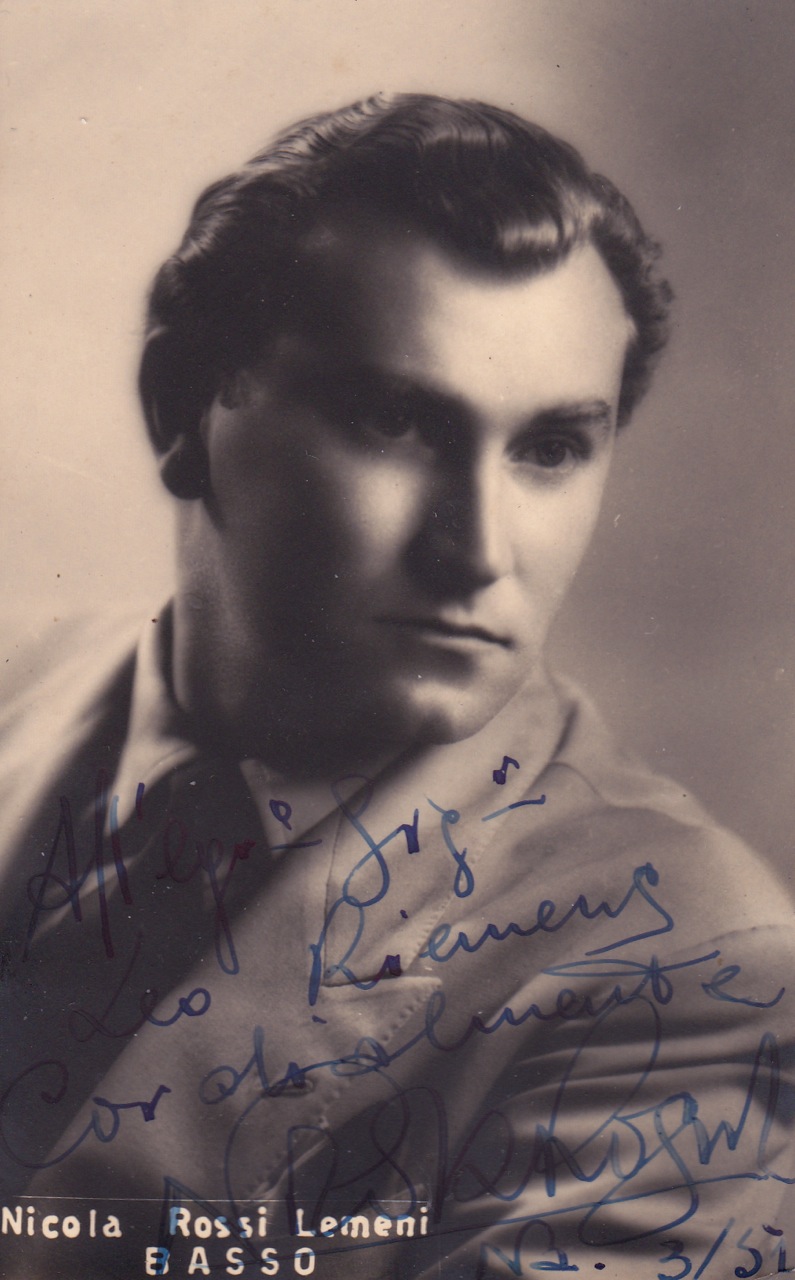 (Rossi-Lemeni + Jussi Bjoerling, Charles Mintzer coll.)
(Rossi-Lemeni + Jussi Bjoerling, Charles Mintzer coll.)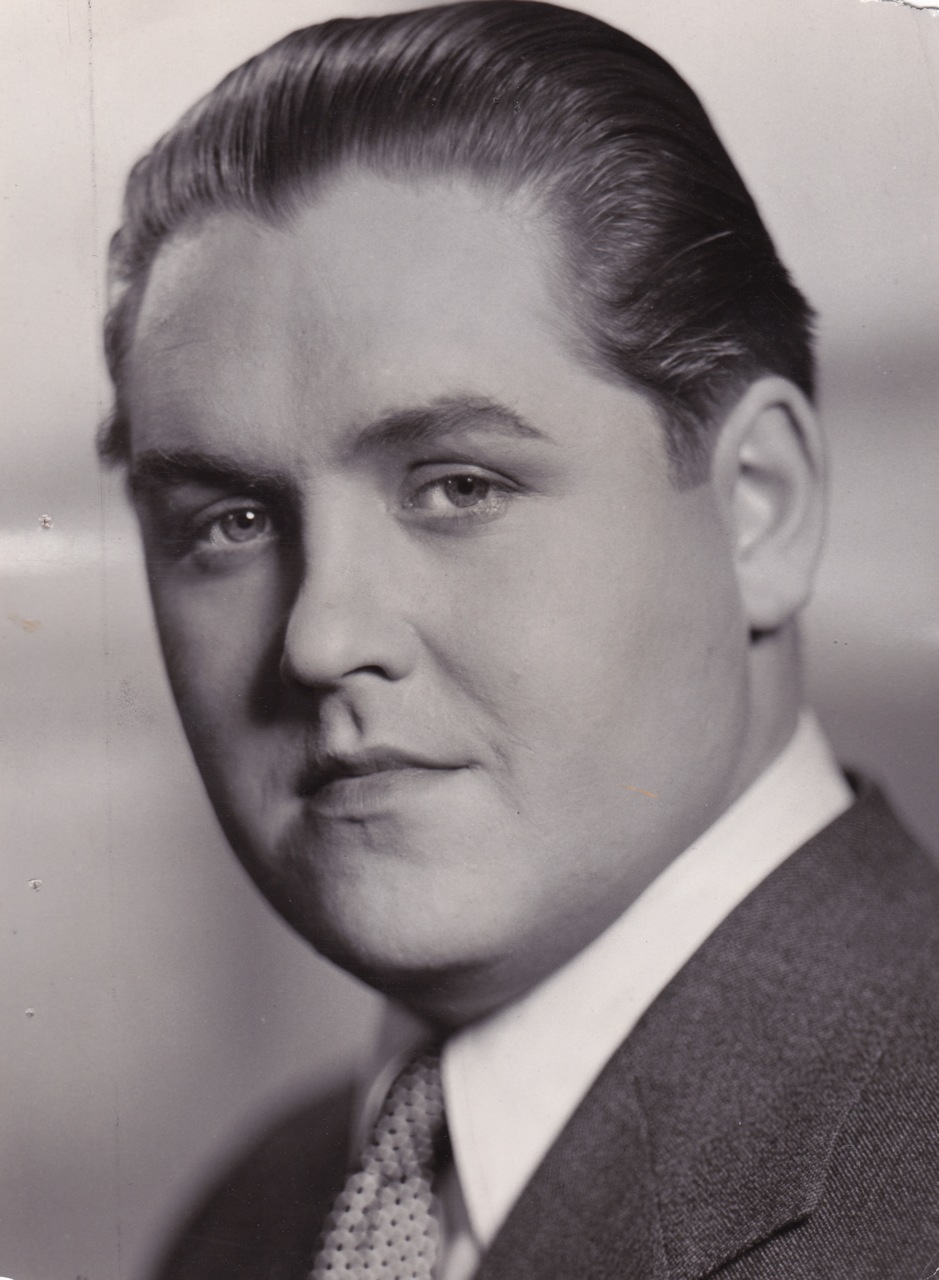
My other favorite tenor of that period was Jussi Bjoerling. Bjoerling was sometimes inconsistent because he would have liked to have been a heavier or more dramatic tenor. He often pushed the voice to try to create a larger and heavier sound. You can hear this fuller sound on the aria recital that was included with the recording of “Cavalleria Rusticana” that he made with Tebaldi. However, when he did this in the theater, it sounded effortful, sometimes muffled, and did not carry as well. It also required much more energy and you might say it was exhausting. For that reason, by the last act or so, he often switched back to his earlier production, which was not as full but had more brilliance and squillo and really carried. That sound could fill the theater in most roles. And when he was singing in this way, which you hear on all of his early records, the voice actually floated in the theater. I heard Bjoerling sing eight times, and would have also gone to hear him on several other occasions had I known his life and career were to be unfortunately shortened. He did not need to sing as heavy in recitals because he was not competing with an orchestra or other singers. Also many of the theaters in which he gave recitals were smaller than the opera houses. One should keep in mind that at that time the larger opera houses in Europe had seating capacities in the range of 2,000 seats more or less, while the majority of the other European houses probably averaged less than 1,000, some even about 600 seats or less. There is a big difference for singers coming to the United States who have to sing here in opera houses that have a total capacity of 4000-6000. Recently I met a long time Bjoerling enthusiast who had heard him sing more than thirty-five times, and he told me that Robert Merrill had also warned Jussi about singing too heavy in the early 1950’s. He is the only tenor I have ever heard that if you heard one good act, it was worth the whole evening. Corelli was also very inconsistent, but if you heard only one good act from him, you still felt the evening was disappointing. Bjoerling and Del Monaco were the two greatest tenors I have heard during the last 60 years, although I have heard many other wonderful tenors who also sang marvelous performances.
Del Monaco was scheduled to return to San Francisco for the 1953 season during which he was to sing “La Traviata,” “Un Ballo in Maschera,” “Manon Lescaut,” and “Turandot.” All the fans in California bought their tickets and were very excited, and then were disappointed (and me especially) because Del Monaco cancelled his appearances a few short weeks before the opening night. This was very unfortunate for the fans because these operas were part of Del Monaco’s repertoire that for the most part, he discontinued singing after that season. Merola again turned to Frank DeBellis and his record collection to find a substitute tenor on very short notice. The “Manon Lescaut” performances were cancelled, and Del Monaco was replaced in “La Traviata” by David Poleri and in “Ballo” and “Turandot” by the Italian tenor Roberto Turrini, who was to become the principal dramatic tenor of the San Francisco Opera for the next four seasons. Turrini also sang Canio in “Pagliacci” with Albanese and Warren on a double bill with Rimsky-Korsakov’s “Le Coq d’Or,” introducing Mattiwilda Dobbs, the first great black soprano and singer to sing with the San Francisco Opera.
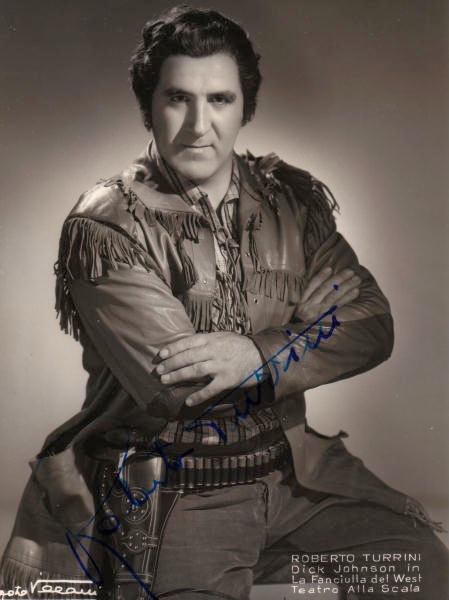 (Turrini in Fanciulla)
(Turrini in Fanciulla) 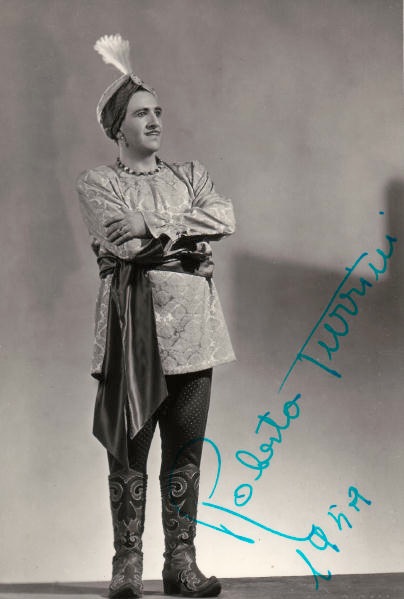 (as Calaf a role which he sang to most of Callas's Turandots in Italy, both photos Charles Mintzer coll.)
(as Calaf a role which he sang to most of Callas's Turandots in Italy, both photos Charles Mintzer coll.)
I next heard Del Monaco sing ten times during the Metropolitan Opera's 1957-58 season. I heard him sing four "Otellos," two with Milanov and two with De Los Angeles, and all with Warren. He also sang four "Samsons" and I heard all four. In addition, he sang several "Andrea Cheniers," of which I heard two. I believe he sang fourteen performances in the house that season and I would have gone to every one of them, had I known what the future was to bring. The opening performance of his return that season was "Andrea Chenier." And out of the eighteen times I heard him sing, that was the only performance he ever over-sang. He apparently was determined to kill the audience with sound that night, and even when Del Monaco over- sings, it interferes with the overtones and sounds more effortful and carries less well. Other than that all the performances were excellent, with one caveat. He was sometimes criticized for singing loud and so for the two broadcasts that season, he sang somewhat softer and with what he must have considered more legato. This was unfortunately misjudged, because the performances that he sang uninhibited and with full voice were glorious. In spite of this, the four "Samsons" he sang fit his voice so easily that he produced an effortless sound that completely covered the orchestra and chorus. These are the greatest performances I have ever heard. The Dalilas were sung by Rise Stevens, a fine voice and beautiful actress, and Blanche Thebom, who was also very good. Both Milanov and De Los Angeles sang reasonably well as Desdemona (the former a bit maternal and the latter perhaps lighter than ideal). Tebaldi had unfortunately cancelled her season due to her mother’s death. Warren was a very great voice, and he sang very well, but his voice was actually too beautiful for nasty roles like Iago and Scarpia.
 (Warren, courtesy Charles Mintzer)
(Warren, courtesy Charles Mintzer) 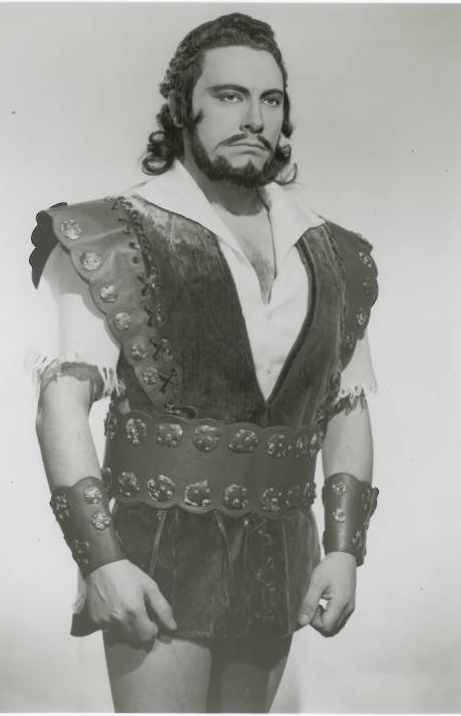 (Coll. David Akins)
(Coll. David Akins)
Bing later claimed that to get Del Monaco back for the 1957-58 season, there were so many additional bonuses and benefits that "No one has had a contract like that since Caruso". I had heard that the Met’s top fee at that time was $1000 per performance, but Rise Stevens had insisted on being paid $1001. A Met career at that time was very important to an artist’s concert and recording career, as well as higher fees from other opera houses for being a Met singer. So Bing was probably paying Del Monaco’s traveling and living expenses as well, and all of this additional expense may have been the reason that he gave Corelli the opening night of the 1960 season with the anticipated consequences, a reasonably good substitute star tenor who was freeing him of a financial burden. This was similar to the strategy of Gatti-Casazza with Gigli twenty years earlier, when he insisted on reducing Gigli’s fee. As a result, both Del Monaco and Gigli left the Met. (about salaries at the Met our contributing editor Charles Mintzer notes the following: Discussion of salaries is often difficult as so many elements and even emotions are present, and comparisons from different decades require additional understanding of changing economics and world conditions. The publicly stated policy of the Met in the early to mid 1950s was that their top salary was $1,000. per performance; however various top artists had negotiated special arrangements that put their compensation above that, and these "perks" were not public knowledge.The pay books housed in the Met Archives reveal that, for example, in the1957-58 season the top salary was $1,500. per performance. Only a handful of artists received this salary including tenors Del Monaco, Bjoerling and Tucker. However, in that season, Del Monaco's unique hold on the role of Otello was rewarded with an extra $500. for his Otello performances in New York and also for all his performances on the spring tour including Samson and his only complete Pinkerton (3 May 1958 in Atlanta). On 2 April 1955 he sang Act I of "Madama Butterfly" with Victoria de los Angeles in a Gala performance].
One of the most incredible facets of Del Monaco’s singing was his beautiful diction. Coming from Florence, he spoke Toscana, which is the national dialect or language of Italy. It is characterized by the very distinct pronunciation of all the consonants and clear pronunciation of each vowel. He developed a very powerful head voice or what the French call ‘voix mixte’ and what Del Monaco himself called reinforced falsetto. This gave a constant brilliance to his singing throughout the entire range of his voice that was never diminished by adding the darkness of the chest voice to it. And while the sound of his voice was full, it was never thick, and this well developed head voice gave it squillo throughout, so his voice was consistently ringing and carried over the orchestra, chorus and other singers. When singing, Del Monaco usually showed his teeth, because as he explained, the sound projected against the teeth gives the tone more brilliance and carrying power. Pavarotti called it "biting" the tone, and I have met an occasional singer who inserts a hard plastic dental bridge in the roof of the mouth for the same purpose He usually sang in the covered position but could sing open and carry up the chest above the passaggio when necessary. An example of this would be his singing in the trio “Oro, quant’oro ogni avido” from act II of “Ernani.” In the phrase “Fu scherno della sorte,” he usually sang the word “sorte” with full chest voice. However, he would often begin notes in the cover and then open the note in the head but usually only two or three times during a performance. Examples of these are “Dio vendicator” at the end of Act II of “Otello,” “O gioia!” at the end of the Act III monologue, and “Gloria” in the death scene. I mention singing open in the chest or throat because it should only be used very rarely as an effect, and is one of the reasons that singers who sing in that position such as DiStefano damage their voices early. Singing open in the head, while less dangerous, should also only be used occasionally for effect. Singing open in the head can produce a very big sound, which eventually becomes very effortful to support, and overall sounds less focused than singing in the cover. Atlantov and Licitra both sang almost everything open in the head, but Licitra in his final season at the Met was trying to sing in the cover. Open singing is often very big but the tone does not make an equivalent impact when it is not well focused.
Del Monaco had an incredible sense of rhythm, and was very faithful to the many markings in the score, especially for the first twenty years of his career. His career really spanned about thirty-five years, from 1940 when he first sang “Cavalleria” at the age of 25, until 1975 when he sang his official farewell performances. As everyone knows, he considered his official debut to be a performance of “Madama Butterfly” in Milan at the Teatro Puccini, December 29, 1940, with the celebrated Japanese soprano, Atsuko Ito. Many sources suggest that this debut was intended to be with Toti Dal Monte; however, she may have been indisposed and Miss Ito substituted for her. Some sources also give the date of Del Monaco’s debut as December 31. However, I read or heard several interviews with Del Monaco during the '50s, in which he always stated that he made his debut in 1941. He pointed out that the theater directors were looking for a tenor with a very good high C because he would be singing with a veteran soprano whose upper voice was no longer reliable. He also said that during the auditions he noticed the directors were talking to each other and not listening to the other tenors sing. He decided that the only way he could get their attention and possibly win the audition was to give everything he had on the final b flat in the tenor aria from "Butterfly." When he finished, they all looked up, and he was given the leading tenor role. He then would mention that he had sung "Butterfly," which was in fact the opera of his debut, with the soprano, Toti Dal Monte, who had a few years earlier recorded the complete opera with Gigli and was very famous in the role. He did sing Pinkerton with Dal Monte several months after his debut. It is my assumption that since he was an unknown beginner at the time, he preferred to associate his name with Dal Monte's celebrity as much as possible, to indicate that he was now an accomplished, professional singer. Having made a recent debut, which was probably known by very few people at the time, associating his name with Dal Monte would give him the kind of prestige that he would not have had with Miss Ito, who was possibly equally new to the Italian operatic scene. During the '50s he never mentioned Ito, and while he may never have directly said he made his debut with Dal Monte, Del Monaco's allusions indicated that he had made his debut with her. The only other reference that we could find of Atsuko Ito was that she had sung "Butterfly" in Novara in September of 1942. Last year Roberto Alagna appeared on a radio program in New York City, and the host asked him how a famous singer could afford to take the time to appear on the program. Alagna responded that now there is so much competition with other singers, and in the entertainment industry as a whole, that even well known singers need as much exposure and publicity as they can get. It was probably this type of exposure and attention that Del Monaco was hoping to achieve by alluding to his performances with Dal Monte. Performing with a star of that magnitude in one of her greatest operas would have indicated that he was now a successful singer rather than a promising debutant.
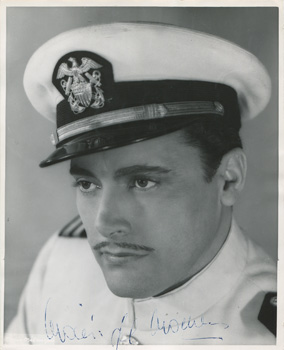 (as Pinkerton, coll. David Akins)
(as Pinkerton, coll. David Akins)
Regarding his fidelity to the score, many people asked why he didn’t hold the B natural in “Nessun Dorma” from “Turandot” on his three commercial recordings. Most tenors sing it this way today, and it has become traditional to hold the B. He usually answered because that is not the way it is written (although he holds the B very slightly longer on his 1954 aria recital recording). Puccini possibly felt that fewer tenors would be able to sing Calaf if they had to sustain the B, and therefore the opera might be performed less frequently. Many tenors at the time of the premiere just touched on the B briefly before going on to the final note of “Vincero.” You can hear that on the recordings of tenors Allessandro Valente and Antonio Cortis. The famed Spanish tenor Miguel Fleta was deemed inadequate at the world premiere and was quickly replaced in performances at La Scala.
To hear Del Monaco’s sense of rhythm, one might listen to his recordings of “Or son sei mesi” from “La Fanciulla del West” recorded in Milan in 1954 (Decca LXT 2929) and “Giulietta son Io” from Zandonai’s “Giulietta e Romeo” recorded in London in 1956 (Decca SXL 2122). There are many other fine examples, and of course, all opera lovers should know his great 1954 first recording of “Otello” on Decca under conductor Alberto Erede with soprano Renata Tebaldi. This recording is an example of the great tonal splendor that Del Monaco possessed during the mid-years of his career. A great moment of declamatory singing comes in the middle of the first act when Otello sings “Abasso le spade” as he interrupts the fight scene. Some critics have complained that Del Monaco’s heroic Otello is not as introspective as some other interpreters, but I believe that is an Anglicism derived from the play. In reality, Otello is a Moor from North Africa who has been made governor of Cyprus by the Venetians because of his great military skills. In their first act duet, Desdemona sings about Otello’s great heroism and suffering, which attracted her love. Otello is the prototypical great romantic hero, although as a man of color, unusual for a period in which prejudice and fear were paramount. This man was indeed exceptional.
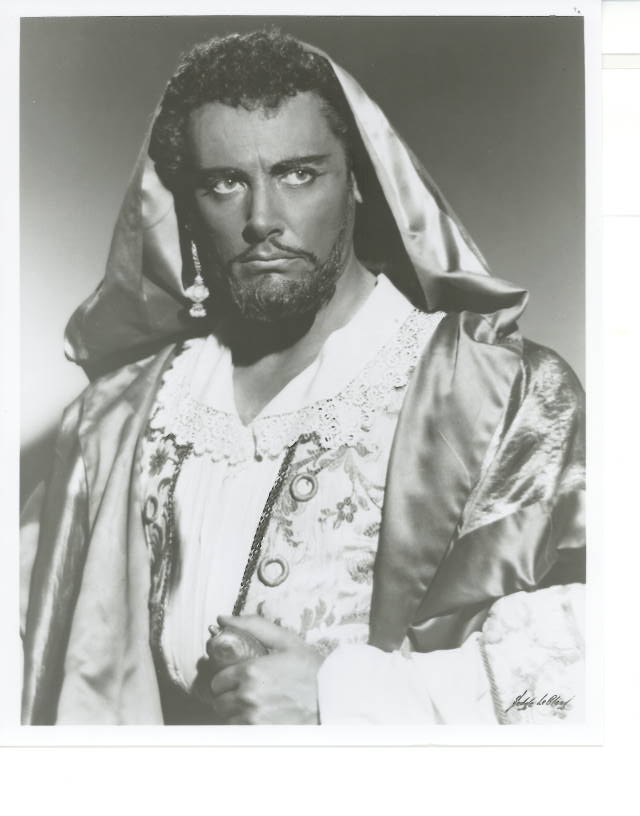
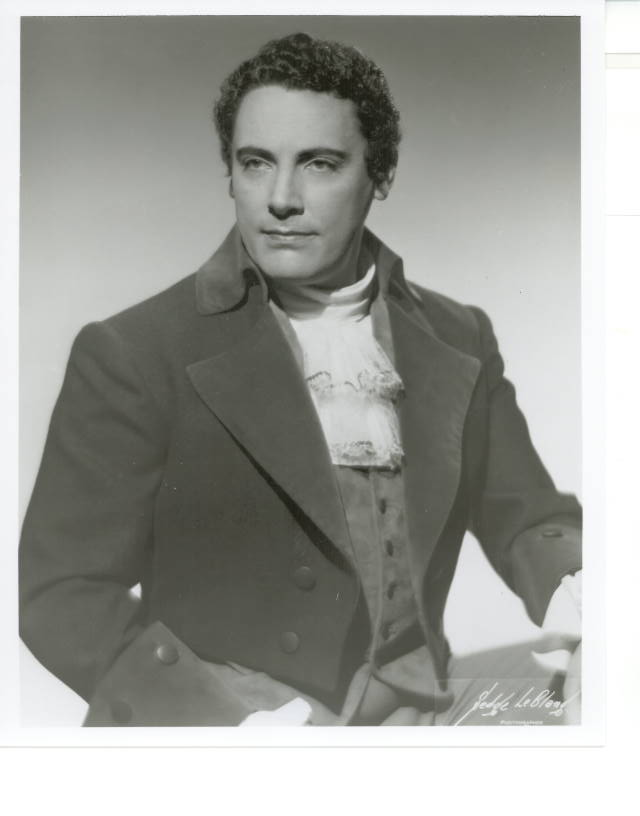
(Met Otello 1952 + Chenier 1954, courtesy David Akins)
Had Otello been more introspective, as some critics suggest, he might have recognized Iago’s true character and become aware of his deviousness. Otello suffers but he is not introspective. He can only question whether he has done anything to deserve these travails. He kills Desdemona not out of vengeance but because he believes it is what justice demands. In act three of “Otello,” Del Monaco was never violent, however angry and troubled he became, all he did was raise his right hand and Desdemona fell. It was not because he threw her down, but because she was overcome with the accusations. Otello actually was a very decent, noble person. He was uneducated and somewhat simplistic and had a traditional sense of fairness and justice for that time. Because of the play, there are many ways of doing “Otello,” and many can be satisfying in their own way without necessarily being accurate representations of the historic reality of the period. Del Monaco also recorded “Otello” several years later in the early stereo period with Herbert Von Karajan, but for complex reasons that recording is unsatisfactory and disappointing. Jon Vickers also told me on one occasion, that of his two commercial recordings, he much preferred the Serafin recording to the Von Karajan recording, which he felt was less spontaneous.
Del Monaco developed his heroic voice for the theater and while he sometimes sang in concerts, on television, or the occasional Italian song, he did not think of himself as a recitalist or popular or ballad singer. He was primarily an opera singer. He did mention that the most difficult music he ever sang was the song “O Sole Mio.” This was because the audience knew the song so well, that you had to give everything, and could not hold back as was sometimes possible during an opera performance. He made at least twelve movies, and opera lovers looked forward to these movies in the early 1950s, at a time when opera performances were fewer and less frequent in the United States. I remember seeing his motion picture “The Young Caruso,” in which he did not appear, but being thrilled by his vibrant singing of “Addio mia bella Napoli” on the sound track.
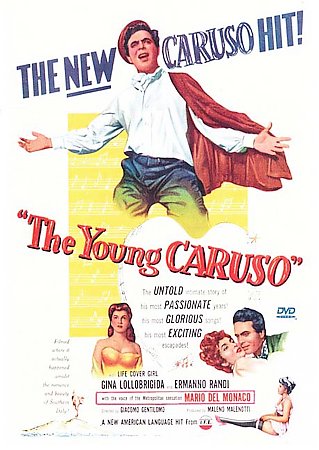
As the years wore on and the voice became more centralized, and it took more energy to sing, Del Monaco sometimes shortened the phrases and would substitute brilliance of attack for volume. He was asked to sing in Las Vegas but declined on the basis that with a voice his size, he could only sing comfortably twice a week. He also mentioned that lyric tenors or lighter voices could sing more frequently than he could, because it required less physical effort to sing with a lighter voice. His wife was once asked what it was like to be married to a man who was so good looking and so sexy. She answered by saying, “Mario sings twice a week, and for two days before he sings, he saves his energy for the performance. And after he sings, he’s too tired.”
Del Monaco sang a total of 142 performances of sixteen roles over seven seasons at the Metropolitan Opera. His total performances in America would have been somewhere over two hundred performances. Corelli was a great fan of Del Monaco, and unknown to the opera lovers during his career, he often consulted Del Monaco as well as Lauri-Volpi. When Corelli first came to the Met in 1961, his voice was about 20-25% smaller than Del Monaco’s, but of more concern, was that his voice often thinned out on the high notes. According to Stefan Zucker, his best role was Ernani, and in this I would concur, after hearing him at that time in that opera. This is because Ernani only is written to A natural and the additional high notes are added at the discretion of the singer, depending upon how he may feeling at that performance. Not only was Corelli a very insecure musician, but with the high notes often being thin, I considered him an often unsatisfactory substitute for Del Monaco. However, Corelli worked very hard on his voice and technique, and his voice continued to improve and he himself stated that his best vocal years were between 1966 and 1968. His emotionalism was often a technical device, similar to Gigli’s, where the sobs were an attempt to lighten the voice particularly in attacks to maintain the head voice and sing in the upper register. On days when he was particularly insecure, this might begin early in the opera and occasionally the audience would experience this as comical. I heard a performance of “Carmen” with Grace Bumbry in Chicago where he was sobbing throughout the entire first act.
Actually, the most popular tenor at the Met during the 1957-58 season, other than Del Monaco, was Flaviano Labo, who had a large and exceptionally beautiful voice. He had an unfortunate Met career because at the end of the first season, he asked to receive the same salary as Carlo Bergonzi. Bing refused his request, and Labo did not return for several years. Labo’s career was hampered by the fact that although his voice sounded very beautiful in the theater, he did not record well; his voice sounded uneven on recordings, especially in the early years. Flaviano Labo was, like Antonio Cortis, a very small man. However, despite the fact that he was approximately five foot four inches tall, he was very handsome and moved and acted well and looked very good on stage. In 1961 Met tenor Dino Formichini would often drop by my apartment in New York City. He would walk in the door, pull out his pitch pipe, and begin to sing "A te o cara" from Bellini's "I Puritani" in the original key. He would just get to the second line of the aria when all the neighbors above and beside my apartment would begin banging on the ceiling and the walls because Dino's voice was like a laser in the apartment building. Dino would continue singing in spite of the neighbors' remonstrances until he had sung the high C sharp at the end of the second verse of Arturo's entrance aria. And regardless of the neighbors, he would say "Senti, David" (Listen, David), and sing one or two more arias, usually from "Rigoletto" and "L'Elisir d'Amore." He had a beautiful lyric tenor that sounded like a small Di Stefano, and in fact, he had recorded Edmondo to DiStefano's Des Grieux in "Manon Lescaut" (with Callas). He had also recorded an LP of excerpts from "La Favorita" on Angel with the young Vittoria Garofalo and Otello Borgonovo. We were talking about Labo one day and Dino said " I was singing in a vocal competition in the early 50's and this young singer came up and sang the death of Otello. I never had heard such a big and beautiful voice and I said to myself, it's all over for me now. However, we both tied for first place and this person with the extraordinary voice was Flaviano Labo."
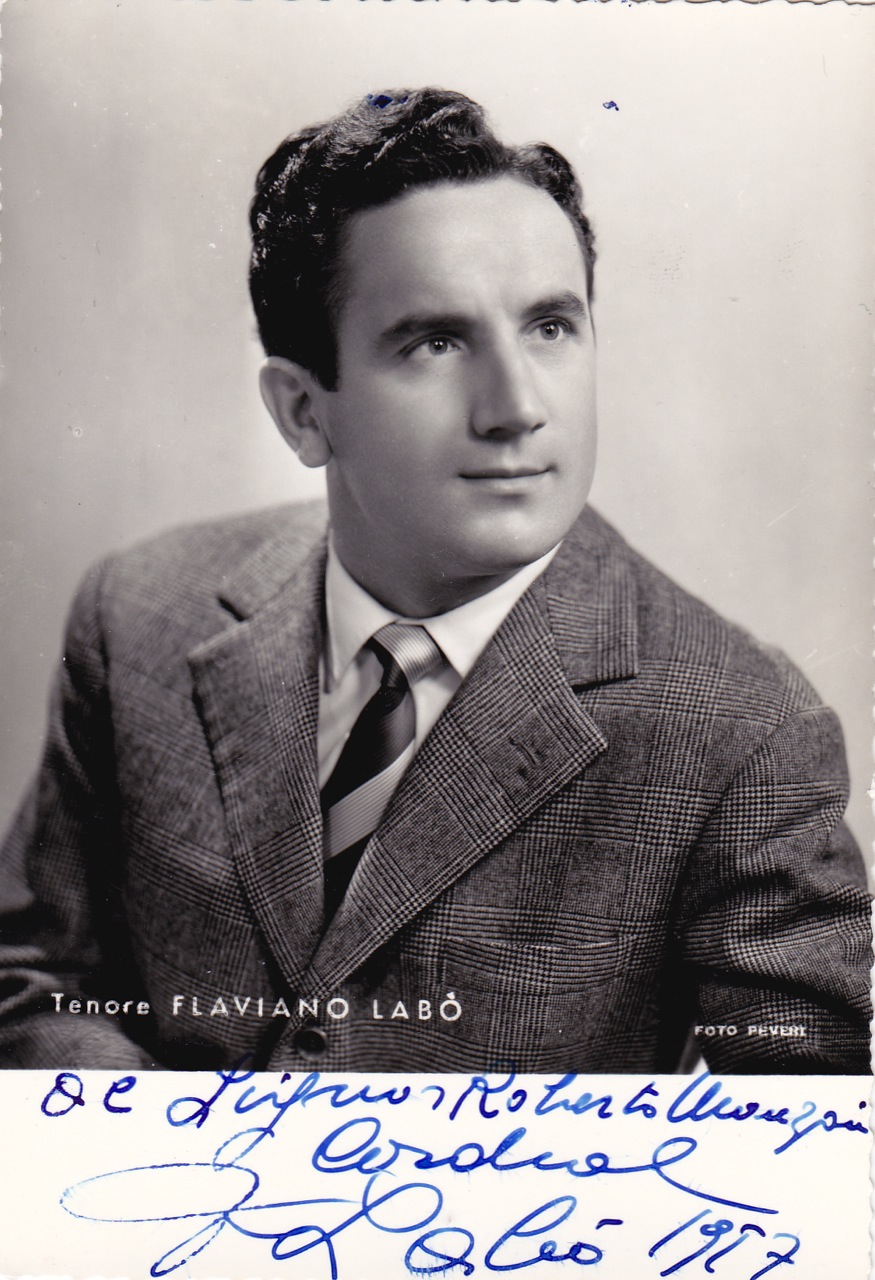 (courtesy Charles Mintzer)
(courtesy Charles Mintzer)
The next time I heard Del Monaco was in San Francisco during the 1959 season shortly after he had returned from singing at the Bolshoi Theater in Moscow. He sang "Otello," "Andrea Chenier," and "Pagliacci," his three main warhorses, all of which I heard at the 6000 seat Shrine Auditorium in Los Angeles. The Shrine is an immense theater with fine acoustics, in which all of the world's greatest singers had sung since 1919. This would include the Met, Chicago Opera, San Carlo Opera, and Scotti Opera on tour. The "Otello" there was the greatest performance of both “Otello” and Del Monaco that I ever heard. The walls of the theater were actually vibrating with the splendor of his voice. The Desdemona was Gabriella Tucci, who always called Del Monaco "her tenor" and the greatest tenor she'd ever sung with. The Iago was Mario Zanasi, who I was afraid was going to be underpowered for the part. I had already heard him many times and his voice was very light on the bottom, was narrow in the middle, but blossomed on top. Surprisingly for me, he was fine, for while Iago's music is dark, most of it lies high. The drinking song goes to A natural, the "Credo" is declamatory and most of that is high, and the outbursts in the duet with Otello and the second one at the end of the act also lie high. So he worked out fine. The "Andrea Chenier," with Tucci and Robert Weede, was also excellent, and Weede, who sang with the San Francisco Opera for well over 20 seasons, was the best American baritone after Warren, MacNeil, and Merrill. He sang all of the Verdi beautifully and was famous for his Scarpia and Michele in "Il Tabarro." You can find his recording of "Tosca" with Callas and Mario Fillipeschi, from Mexico City, in the early '50s. He sings effortlessly. The final performance was "Pagliacci," with Tucci and Weede, but at this point, Del Monaco was now wearing his light blue pants, rather than the full Caruso style Canio costume that he had worn for years. His acting was also becoming more exaggerated, and his Canio was now becoming mentally ill. A friend accompanied me to the performance of "Otello" who had recently heard Del Monaco in several performances of "Otello" at La Scala. He said this was the greatest Del Monaco performance of "Otello" he had ever heard. And of course, I agree. Del Monaco's acting and singing were very noble in style. Later his singing and acting would become more exaggerated.
At the end of the 1950’s Del Monaco encountered some legal problems in Italy, and he also left the Metropolitan Opera at the end of the 1959 season. He claimed this was because Bing had promised him the opening night of the 1960 season with “Andrea Chenier” and now had given it to Corelli without even discussing it with him. Because of this and his later disability from an automobile accident, Del Monaco never sang at the Met again. Essentially, his major American career had ended with his final performances in the 1959 season, although he later sang a number of performances in Philadelphia, Dallas, and San Francisco.
Del Monaco suffered from critics and many people who did not understand his genius. And due to this, he began to question his talent and possibly become unsure of himself. Del Monaco could understand and enjoy the singing of many singers, but he often mentioned that the only tenor that he really admired was Giuseppe DiStefano, because of his beautiful voice and very expressive phrasing. I can only speculate that due to this court case and the constant criticism, that Del Monaco was losing some of his self-confidence and for a while began to sing in a much broader fashion that was somewhat similar to DiStefano’s style. Perhaps he was just trying to sing with more legato or maybe also due to advancing age, it was becoming more difficult to give as much as he had given in the past.
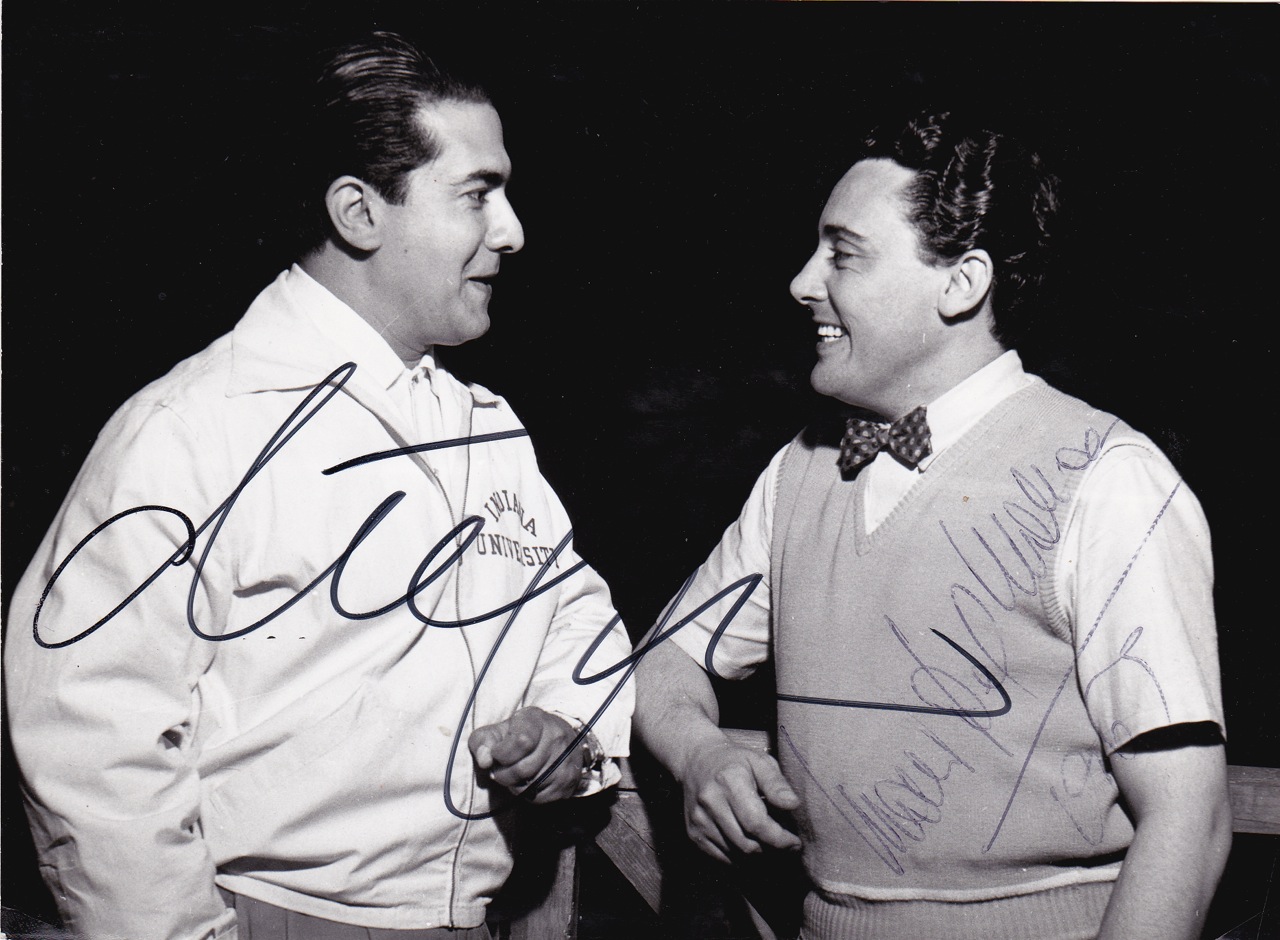 (tenor buddies, MDM w. Di Stefano, courtesy Charles Mintzer)
(tenor buddies, MDM w. Di Stefano, courtesy Charles Mintzer)
The kind of criticism that Del Monaco received must have been very painful for an artist of his sensibility. He was often accused of just being loud and coarse. That may be before some people realized that loud is good and heroic is not coarse. Many great artists have had problems in this area. As Robert Merrill used to say after he first heard Del Monaco in a rehearsal of “Il Trovatore,” in which Merrill was singing the Count di Luna, “his voice was like a trumpet that pinned us all to the wall,” or the approximation of that. Most people, including many famous singers, had never heard a great voice like that.
b
There is no doubt in my mind that Del Monaco’s genius, his gift coupled with self-assurance and feelings of self-worth, and wonderful appearance, were a threat to many critics and individuals who felt overwhelmed by his charisma and one-of-a-kind greatness. I think perhaps the best short example of how Del Monaco looked in performance is to see his act one aria “Un di all’ azzurro spazio” from the Tokyo performance of “Andrea Chenier.” This is very close to how Del Monaco really looked and sounded in performance, and you can both hear and see the audience reaction.
Many of the operas that were recorded by RAI (Radio Televisione Italiana) were actually recorded first and filmed with the singers lip synching and are sometimes marred by the director’s perspective, available finances, and the technical and lighting limitations of the early television period. In some of the later TV and recorded performances that begins to be some exaggeration as Del Monaco moves more freely away from the noble and classic performances of the 1950s.
(programme of the Domingo Cassio, courtesy Charles Mintzer and film clippings of Del Monaco's first Otello with unique footage of Buenos Aires, the Colon, Rina Del Monaco, Sol Hurok (?), Clara Petrella and Antonino Votto) Note by David on the Buenos Aires footage :
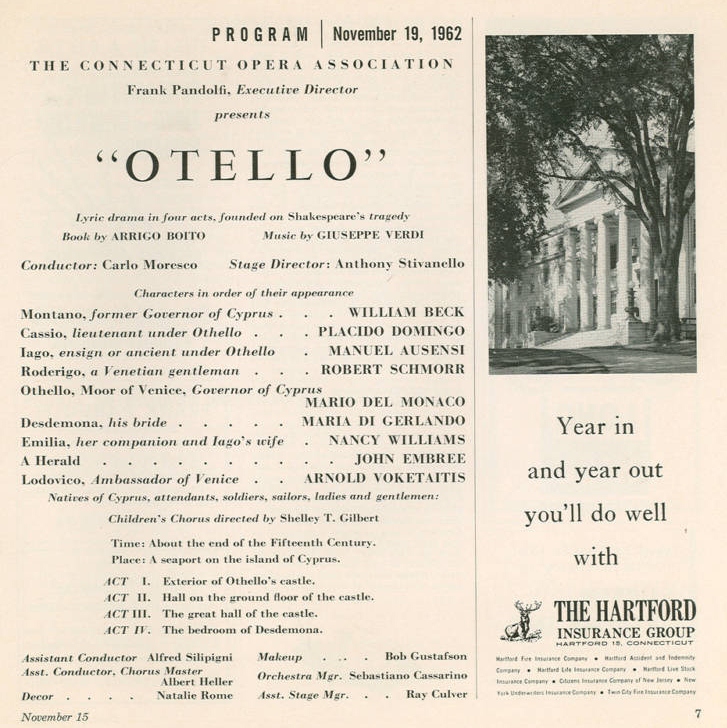 <
<
Placido Domingo sang Cassio to Del Monaco’s Otello at the end of 1962 in Hartford, Connecticut. He later said that he would never be able to sing Otello like Del Monaco because he did not have the same type of voice—Domingo being a somewhat lighter spinto, instead of a dramatic tenor. However, initially there were similarities especially in the first, second and fourth acts of Domingo’s Otello. The difference in impersonation was largely in the third act where Domingo’s Otello was more violent than Del Monaco’s. This is possibly a mistake, because the tragedy of Otello, besides the death of Desdemona, is of a good and noble man, deceived and betrayed by forces beyond his understanding and control. Desdemona has betrayed him, his trusted lieutenant Cassio has also betrayed him, and now unbelievably, Cassio is replacing him as governor of Cyprus. While in reality, the only person who has really betrayed him, is Iago. That is why if Otello responds violently to Desdemona, he becomes just some primitive person from the ghettos of North Africa, rather than a noble leader and warrior, and loses the audience’s sympathy. There is no doubt that having to deal with all this treachery by the people he loves and trusts is making Otello mentally ill by the end of the third act, but the act should not begin that way. In the last several years of his performances of Otello, to his credit, Domingo became more reserved and to that extent, more similar to Del Monaco’s concept, which is Otello seeking justice, not vengeance. By the time Del Monaco sang Otello for Japanese TV, he was using dramatic accents more often than the full voice he used years earlier, although he always gave more than enough. There is no way that anybody at the time would ever have expected that these films would have been around years later as a visual record of a singer’s career, rather than just a one night show. The cost of getting a personal copy of a television performance fifty years ago was astronomical. This explanation about Domingo is because as the most recent successful interpreter of Otello, it can give some insight into Del Monaco’s performance and that even as Domingo’s voice grew in size over the years, Del Monaco’s voice was still much larger and more brilliant.
Another problem with listening to singers of the past is that many of us can only know them from recordings. Recordings can give you some idea about the singer’s phrasing and musicality, about whether the voice is bright or dark, and about the singer’s approach being more or less idiomatic. This is often misleading because you cannot judge accurately the size of the voice, the actual beauty of the voice, or the charisma of the singer in person. A dramatic singer’s upper voice may be two to four times the size and carrying power of that same singer’s middle voice, but it is difficult to tell this on records, because the recordings tend to equalize the sound. That is why techniques had to be developed to keep singers from blowing out the sound equipment on the fortes and the high notes. And that is why Del Monaco, like Warren, is one of the most difficult voices to reproduce and adjust the sound accurately when listening to their recordings. In reality, though, for most people who listen to singers on records, this doesn’t matter, because if you have not heard the singer in person, it is impossible to judge. For most people it is merely a question of whether they like the sound of the singer on record and find the recording enjoyable. Many record collectors rarely go to the opera because they prefer to spend the money on records. In order to properly evaluate either the records or singers, you have to do both.
As I'm sure you know, Del Monaco had a serious automobile accident, I believe, in December of 1963, when he was 48 years old. He broke all of his ribs, his pelvis, and very severely damaged his kidneys. He was on dialysis several times a week for the rest of his life. He resumed singing within the year but his voice was one-half the size of what it had been previously. Where before he had been a great Otello and Samson, now he was a competent Cavaradossi. I was fortunate to hear him again for the last time in Bologna around Christmas of 1964 in a performance of "Otello" with Marcella Pobbe and Giulio Fioravanti. The quality of the voice sounded somewhat similar but he was no longer able to support the huge sound as before. And so a singer who once had been bigger than life on stage had now become just another reasonably good tenor. It is interesting to speculate what Del Monaco’s voice might have sounded like ten or fifteen years later had he not had this disabling accident. Pavarotti’s voice continued to grow and improve until he was sixty or sixty-five.
He returned to Philadelphia to sing Samson a year or two later and besides his regular fee, he received round-trip tickets for both his wife and himself. The stage director for the performance was Anthony Stivanello whose family had both staged and directed operas throughout the Americas since 1924, and the third generation, Roberto, is still working, though it's almost the end of the road. (Their story would make an incredible book.) He and the company felt taken advantage of, for, as he said, “Del Monaco brought his wife, but left his voice in Italy.”
Over the years whenever I was out with singers, especially with tenors, the subject of Del Monaco would always come up. And I never met a tenor who did not admire his great accomplishment in creating this voice. Del Monaco himself called it a miracle of nature. Tenor Michele Molese told me that Del Monaco was the greatest Pollione in “Norma” he had ever heard: “he really had that one down.” And then he said, “You know, he didn’t begin that way. He had to build that voice.”
I was with tenor Luis Lima one day in the ‘70s, and he said “I heard Del Monaco recently and he’s got his voice back like before.” However, I knew that could never be, as Del Monaco himself said before he made his final appearances in Vienna in 1975 as Canio in “Pagliacci”, “it’s nice to be going back after all these years but it can’t be the same.”
After his “official” retirement in 1975, Del Monaco taught many famous singers. One might say that all of the more dramatic tenors of the 60’s, 70’s, 80’s and 90’s were influenced, if not taught by Del Monaco. For a sampling, just try listening to the performances on records that include Cecchele, Martinucci, Bartolini, Miranda-Ferraro, Giacomini, to some extent, and many others.
Vladislav Piavko, the Russian tenor whose parents migrated from Sicily to Siberia early in the twentieth century, once told me he went to see “Carmen” at the Bolshoi as a young man in June 1959. He heard Del Monaco, and it was so exciting, he decided to become a tenor, and he found the Carmen, Irina Archipova, so attractive, he decided to marry her. As opera enthusiasts know, he accomplished both goals.
About fifteen years ago, I was talking to the Italian tenor, Franco Bonanome, who had a medium sized, spinto voice of good quality and the kind of excellent technique that enabled him to sing most everything several nights a week on international tours. He mentioned how Del Monaco had helped him early in his career. He was singing Alfredo in “La Traviata” at the San Carlo Opera House in Naples, when Del Monaco, whom he had never met, came back to his dressing room after the performance and said, “You have a very nice voice, but you’re only using half of your voice.” Franco said that was the beginning of his transformation from Alfredo to Manrico and Radames.
In the mid-seventies, I heard Peter Hoffmann sing a concert with orchestra of the music of German composers. I was impressed that his voice was a very beautiful and large lyric tenor. I went back and asked him why he was not singing operas like “Tosca” and “Don Carlo,” which would really have suited the quality of his voice. His response was that he had already sung over one hundred “Walkueres.” Unfortunately it would seem that very many German tenors feel that it is culturally necessary to sing Wagner even though the tessitura and vocal demands may not be beneficial for their voices, although the music is very beautiful. Psychologically Wagner’s music represents the German hero, and that might be an attraction. We chatted about Melchior and other subjects, and a few months later, I read an interesting article from Italy. The article quoted Del Monaco as saying that Peter Hoffmann had come to see him for voice lessons, but that unfortunately, he was unable to help him, because Hoffmann had already damaged his upper voice.
Other than singing the Italianate “Lohengrin” which Del Monaco felt was too lyrical for his voice, and which he only sang during one early season at La Scala, he refused all offers to sing Wagner until the end of his career, saying “I would like to sing Wagner, but to sing it the way it is supposed to be sung, would damage my upper voice.” He was scheduled to sing in “Rienzi” at la Scala, but was replaced by DiStefano, and turned down an invitation from Wieland Wagner to sing “Lohengrin” at Bayreuth. He did, however, sing three performances of “Die Walkuere” in Stuttgart in 1966 in the later years of his career.
Del Monaco sometimes mentioned that retiring was a bit like dying, and he was always a bit ambivalent about the automobile accident that ended his major career. He loved cars, and was very surprised that he could be injured so seriously by something he really loved. In that sense, there was a certain parallel in his life with Otello, who was also damaged by what he really loved. According to Del Monaco, he sang 425 performances of “Otello” and made two complete recordings of the opera for Decca. That would have averaged approximately seventeen performances per year for the twenty-five years after he began singing the role. Some biographers feel that he sang fewer performances. This number may have included dress rehearsals, which were often sung full voice in front of an audience. He died in Mestre on October 16, 1982, at only sixty-seven years of age. He asked to be buried in his Otello costume and was laid to rest in the cemetery in Pesaro.
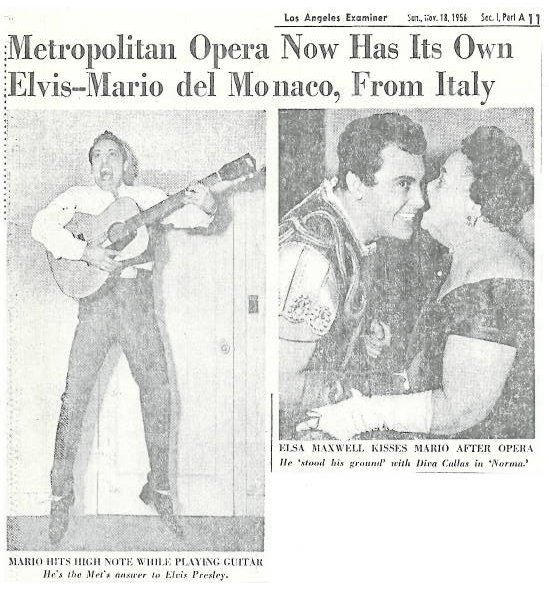 (courtesy David Akins coll.)
(courtesy David Akins coll.) 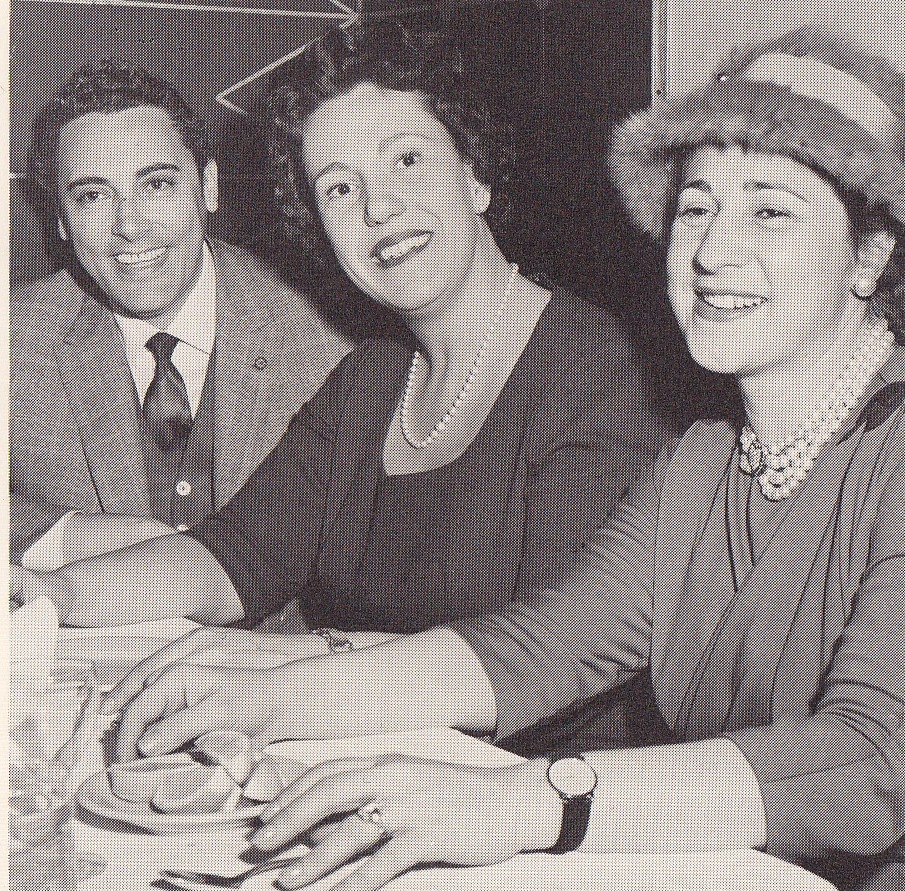 (Mario, Carol Fox and Rina del Monaco)
(Mario, Carol Fox and Rina del Monaco)
I would like to thank my wife, Janyce Wolf, for all her efforts in writing this article. This consists entirely of my opinions, and so may not be construed as absolute fact, but that’s for the readers to decide for themselves. I have also to thank Charles Mintzer, who is kind enough to edit this and check many of the facts, but is better known as the superb author of the biography of the great soprano, Rosa Raisa. I also am indebted to Rudi Van den Bulck, who is a great Mario Del Monaco enthusiast and without whose request and prodding I would not have set down these reminiscences. I must also apologize in advance to anyone’s feelings I may have offended by any of the observations I have offered. Almost every singer singing in a major opera house, and even a minor opera house, has some gift to offer. Franco Corelli once said that no singer is perfect but of course, some are better than others and often for reasons that the singer may not be responsible for, such as size of voice, for example. However, to some extent one can only learn by observation and evaluation because it is through serious consideration that artistic improvements can be made. Please understand that any criticisms that I may have made of any artist here are very minor compared to what these people have achieved in their careers. It requires something very special to sing in all the great opera houses of the world, and everyone here has those qualities, and their careers can speak for themselves. Should any of the readers have any questions, or wish further information, I would be very happy to respond as able through Opera Nostalgia. May I thank you for your interest and patience in reading this article.
Perhaps you or your friends might do me a favor. I have been looking for Del Monaco's Italian autobiography, "La Mia Vita, I Miei Succesi" and have been unable to find it in America. If you can find a copy any place, I will be very happy to pay you whatever is asked, plus the postage. Also, I would be very happy to hear what your experience was as a young person hearing Del Monaco and what it was about his performance that made him your favorite tenor? Was it perhaps a combination of the visual because he usually looked terrific in anything he did, and his vocal performance that evening, or possibly hearing his earlier recordings afterwards?
With every good wish to you and hoping you have a wonderful new year.
David Akins (January 2013)
P.S. Both Bjoerling and Alfredo Kraus were great admirers of Del Monaco. Bjoerling often said that Del Monaco had “the perfect voice for Radames.” Friends that heard Bjoerling sing Radames in Chicago during the mid ‘50s with Rysanek thought his voice was too light for that role in a large theater. However, I heard Bjoerling sing “Manon Lescaut,” “Don Carlo,” and “Trovatore” at the Shrine, and his voice was fine for those three operas. Bjoerling asked Bing to let him sing Radames at the Met during the 1960 season, but Bing turned him down. Unfortunately for us all, Bjoerling died before the season began. I was fortunate to hear his last performance in America, a concert in Pasadena, California, where he had heart problems in the middle of the recital and paused for a half hour before continuing. So within two or three short years, all the gods had fallen. di Stefano and Tagliavini had damaged their voices, and Lanza, Bjoerling and Warren were dead. And Del Monaco was no longer Del Monaco.
Note from the editor
Operanostalgia wishes to thank Cesar Dillon for correcting a factural error about the Favorita recording
Please visit our youtube channel to listen to some Mario Del Monaco rarities not available elsewhere on the web. Click here. Here's an example